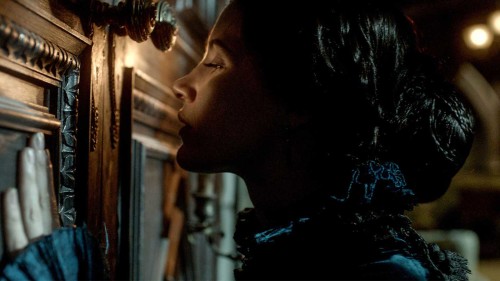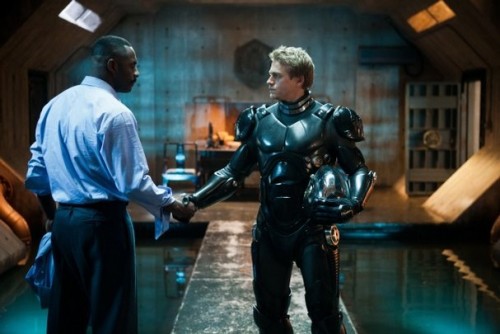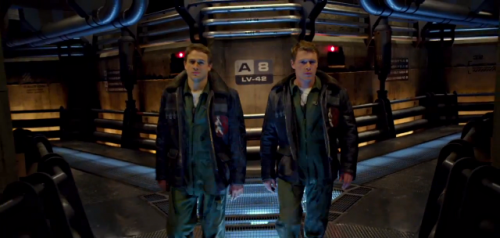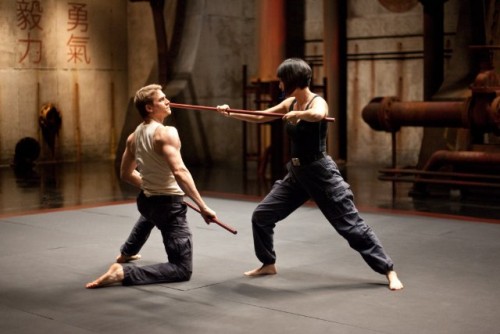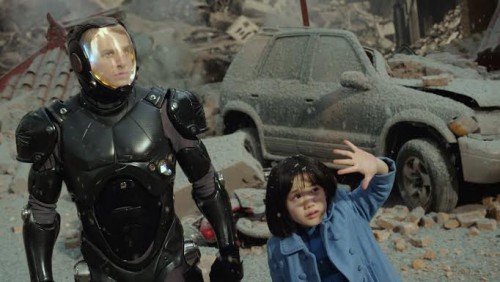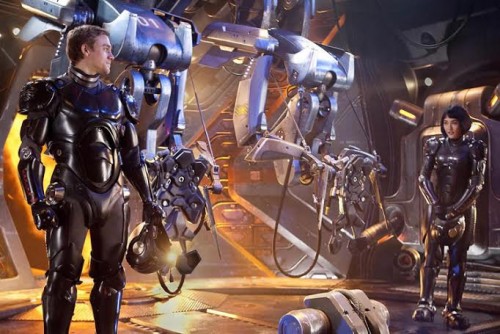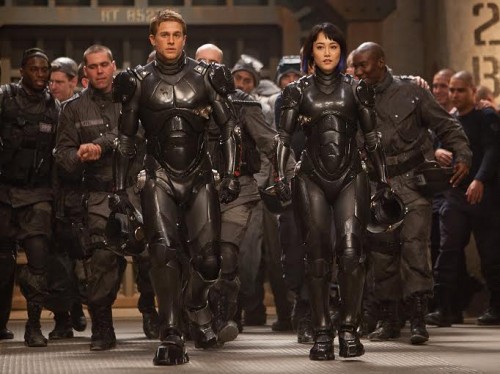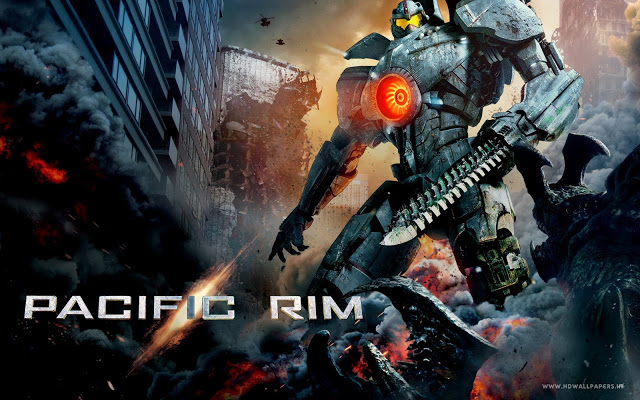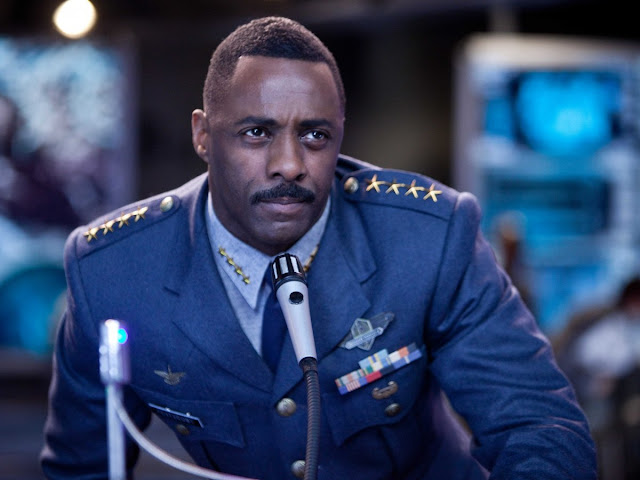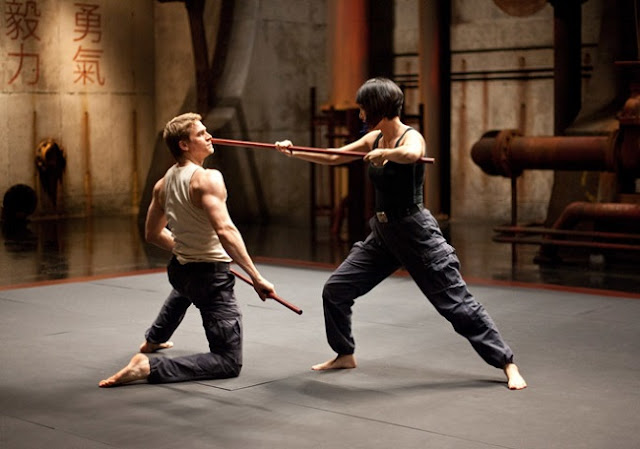Guillermo del Toro’s eye-poppingly gorgeous new horror film/gothic romance, Crimson Peak, has generated mixed reviews, even getting panned by critics who acknowledge its aesthetic strengths. While complaints about the script (by del Toro and Matthew Robbins) aren’t entirely unfounded, complaints about the film’s excesses — from its gore to the batshit commitment of Jessica Chastain’s over-the-top performance, to the visual splendor itself — seem to misunderstand the filmmaker’s aim. Your mileage may vary, as always, but del Toro seems to be in complete control here. The movie is consistent in its vision, and consistent with the filmmaker’s work as a whole.
As he’s done throughout his career, del Toro mines the past for inspiration, then puts his own dark twist on the material. Crimson Peak‘s antecedents include Jane Eyre, Hitchcock classics like Suspicion and Rebecca, and the equally blood-drenched Hammer horror films of the 1950s-1970s. A horror geek of the highest order, del Toro makes loving use of the mood and plot elements of these older works, but makes the material his own.
Crimson Peak‘s connection to the “women’s pictures” of the ’40s and ’50s, and particularly Hitchcock’s Rebecca, is instructive in reading it as a feminist film. Del Toro takes the tropes of a goodhearted, innocent protagonist, an oily older suitor, and a dangerous female rival whose hostility to the heroine is in part motivated by an “inappropriate” sexual desire, and recontextualizes them. He makes the heroine, Edith Cushing (most likely named for Hammer star Peter Cushing), not merely an aspiring author who’s recently written a ghost story (“the ghost is a metaphor,” she explains), but the author of her own fate. As played by the consistently excellent Mia Wasikowska, Edith is a brave, resourceful, and powerful woman, with her own sexual desires.
Tom Hiddleston is Thomas Sharpe, British nobility fallen on hard times. Thomas is charming but weak, as he is batted about by the passions of the two powerful women in his life.
Chastain plays Lucille Sharpe, and from the beginning, both actor and director relish the character’s seething menace. There’s no doubt from the moment Lucille is introduced that she’s bad news, and that she’s running the show. As she explains threateningly to Edith early on in the film, Lucille is that black moth, thriving on dark and cold, and feeding on Edith’s pretty butterfly. It’s not a logical point in the film for Lucille to issue that veiled warning, but it delivers the intended chill, and, as with those ghosts, is a keen metaphor.
Edith is a frustrated author, living in turn-of-the-last-century Buffalo with her wealthy industrialist father, Carter (the great Jim Beaver, beloved of HBO’s Deadwood, bringing an unusual but perfect gruffer-than-thou haughtiness to the role). Edith has personal experience with the supernatural. Her mother’s ghost issued a mysterious warning to her, as a child: “Beware Crimson Peak!” But Edith’s ghost story is not taken seriously because of her gender. She has a suitor, Dr. Alan McMichael (Charlie Hunnam), an ophthalmologist with an interest in Sherlock Holmes, but he clearly doesn’t inspire her. Then Thomas Sharpe comes into her life. He’s handsome and charming and seems genuinely interested in her work. Sharpe is looking for a partner to fund some technical advances at his red clay mine in England, but Carter sees through Sharpe’s charm to his financial desperation.
Noting Sharpe’s interest in Edith, Carter hires a private investigator (Burn Gorman) to look into Thomas and Lucille, and what he uncovers (not revealed to the audience until later in the film, but it should be increasingly clear to all but the densest viewers what’s going on here) is unsettling enough that he threatens Thomas and Lucille with exposure if they don’t leave town immediately, sweetening the deal with a bribe, payable only if Thomas breaks Edith’s heart before he leaves. Thomas knows just how to do it, too, attacking her writing ability.
One gruesome, beautifully staged murder later, Edith is a new bride on her way to Allerdale Hall in England. Her mother’s ghost probably should have told her, “Beware Allerdale Hall!” and not referred to the place by its nickname, which Edith doesn’t find out about until it’s too late.
Allerdale Hall is a wonderful, creaky setting for a ghost story. It’s a classic haunted house, ancient and decrepit, filled with secrets and fluttering black moths. It’s built atop a deposit of red clay, and the blood red seeps into the building through the floors, walls, and pipes. Filled with mournful ghosts, it’s the perfect setting for a scary story, even if its true horrors are contained within the hearts of its living inhabitants.
It seems clear to me that del Toro is less concerned with creating a steel trap of a plot, which he fails to do in any case, and more concerned with atmosphere and with the emotional twists and turns of the story. If you’re chuckling and aghast at the film by turns, it’s working.
Even its detractors admit that Crimson Peak has atmosphere to spare, but they don’t give enough credit to del Toro and his collaborators (chief among them cinematographer Dan Laustsen and production designer Thomas E. Sanders) for creating a work that’s both gorgeous and extremely personal and unique. Crimson Peak is beautiful, but it’s not picture-postcard beautiful. It doesn’t look like a commercial for anything. It’s a fully realized vision of decay, gore, and grue. The playful transitions del Toro uses, those endearing wipes and irises, make it clear that del Toro is relishing the artificiality of it all. The performers play it straight, though, giving the story emotional heft despite that artifice.
Some have complained about the role the ghosts play in the film, but it’s as Edith says, they’re only a metaphor. They serve their function by being beautifully terrifying in their warnings to Edith. And their look — captured in the horror of their untimely deaths, wispy, smoke-like tendrils splaying out in every direction like flayed skin — is unique. It’s one of the few examples I can think of where CGI brings a unique visual sense to the horror — where it’s used expressively, and not just as a way to indicate scale, or to do things to the human body that can’t actually be done on a film set. These beautiful, unsettling ghosts are unlike any I’ve seen onscreen before.
Edith falls ill as she unravels Lucille and Thomas’s plot. Thomas begins to develop genuine feelings for his mark, enraging Lucille. Alan, meanwhile, begins his own stateside sleuthing, uncovering the truth about the Sharpes. During the film, I felt like Hunnam’s adenoidal performance was the weak link of the film, but again, I feel like this is something del Toro intended. It’s clear that neither Alan nor Thomas is truly worthy of Edith.
Her passion for Thomas is real, however, and eventually, she gets him away from Lucille long enough for him to have sex with her, on her terms. He’s weak and devious, but she wants him, and takes control of the situation to have her way.
For a while it seems Alan might save Edith, the damsel in distress. Those familiar with del Toro’s work know better, though. Since his second feature, Mimic, he has always had strong female characters in his films. In this instance, the strongest, Edith and Lucille, are destined to settle their score while the men look on from the sidelines.
If you’re alternately giggling and gasping, the movie is working. It’s outlandish and baroque, but the actors keep it grounded, and I found myself moved, not just by the passion of the characters, but by the evident passion of the filmmaker for the material. Crimson Peak may actually be Del Toro’s masterpiece. I’m convinced it is every bit as heartfelt and coherent as Pan’s Labyrinth, widely considered his best. This is a filmmaker working at the height of his abilities to deliver a grandly entertaining, uniquely gorgeous, and emotionally involving work of cinema, with a pronounced feminist bent.
Click here to see Del Toro discussing the film.
